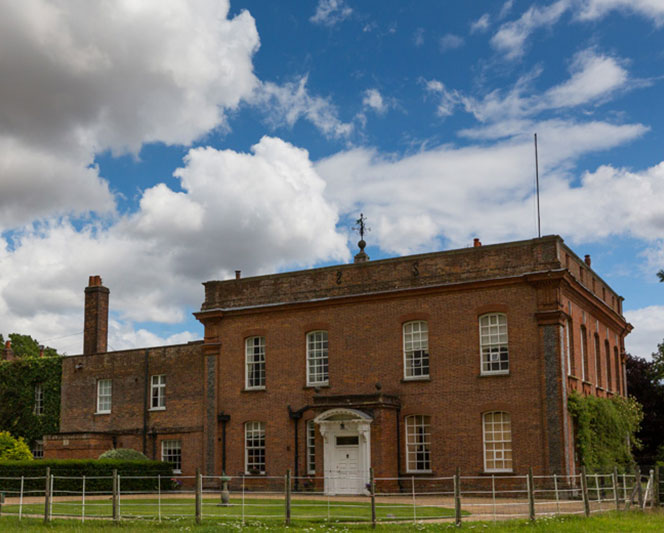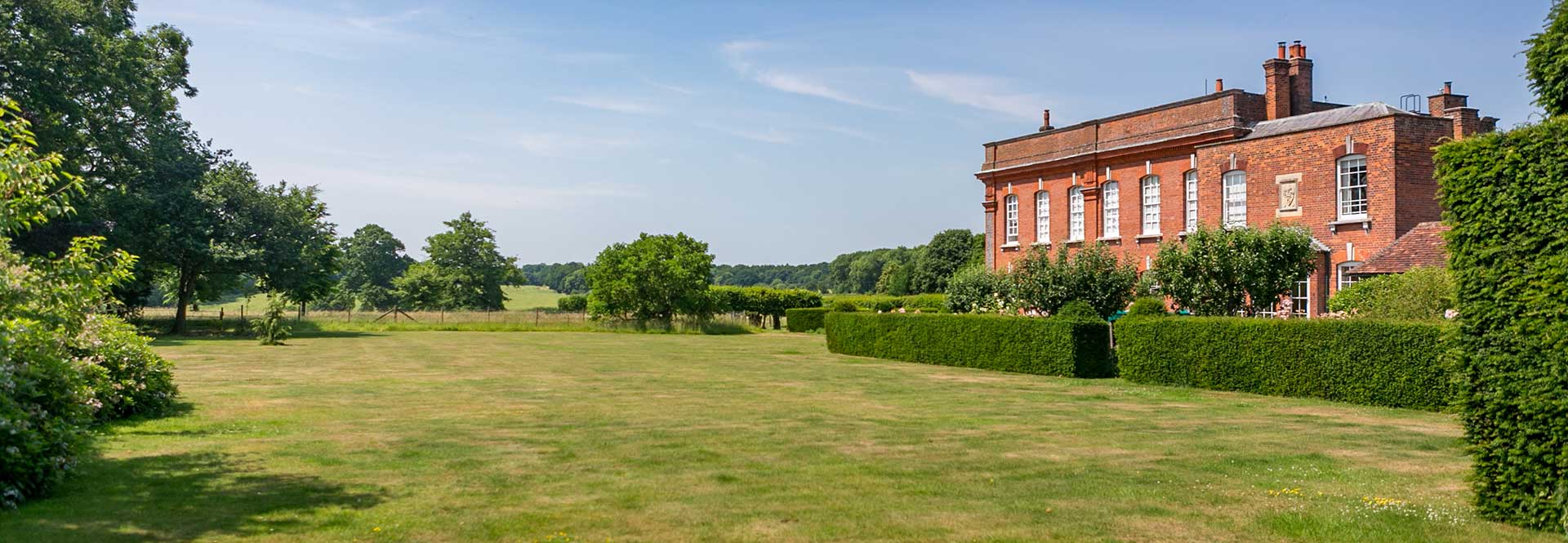What a beautiful autumn it was. The trees and bushes were bright with their seasonal colour, ranging from the yellow of the ashes through gold to the bright reds of the North American oaks, particularly the Pin Oaks. Contrasting with the greens of the slowly turning oak foliage this all makes for a really beautiful sight; how fortunate we are to be able to live in leafy Hertfordshire.
Farming
Following last summer’s drought, we have been blessed with enough rain to get the autumn sown crops onto a good start. The soil, particularly where it was grazed with sheep (the traditional expression is that it has benefitted from “the Golden Hoof“) is in good heart and has come through the winter reasonably well.
In the autumn we drilled our first crop of organic wheat, a breadmaking variety called “Extase”, in Great Almonds, Long Meadow and Reynolds Field. This has looked good through the winter, but is now beginning to suffering from disease. The variety generally has good resistance, which is one of the main reasons we planted it, but the lush growth in a kind autumn has allowed a disease called Septoria to creep in. This attacks the green leaf of the plant, hindering its ability to photosynthesise, and is spread by the splashes of raindrops. Being organic, the options available to us to treat it are very limited, and as I write some sheep are being moved onto it for a short term graze. Such scenes were common before the advent of modern fungicides, and it is hoped that they will quickly eat down the plants, removing the diseased leaves and allowing the plants to put on fresh clean growth. The timing of this is critical, as the plants will want to start growing rapidly as the spring weather warms, and we do not want to hinder this.
As well as our organic wheat, we are also growing some wheat for a company called Wild Farmed. You may have seen their products in the bakery section of M&S. This is a blend of heritage varieties, some of which will grow to head height, that is planted alongside some field beans. The whole crop will be harvested together and the beans and wheat separated in the grain store. The aim of growing two crops in the same field, at the same time, is to increase the biodiversity within the field, to harness some symbiotic relationships to benefit both the plants and the soil, with the aim of both improving the soil health and producing food that has a higher nutrient density than that from conventional mono-cropped plants. Like organic, this is grown largely without artificial inputs, although some fertiliser may be applied, subject to analysis of any deficiencies within the growing plants. It is certainly an interesting experiment and can be seen growing in Robins and Cherry tree on the north side of the footpath between Marsh Wood and the Golden Parsonage.
We also have our conventional wheat, “Dawsum” which has been sown east of Red Lion Lane. “Dawsum” is hard Group 4 wheat, and will go for low grade milling, probably for Weetabix. Elmtree Park and Bingham’s Bottom are growing winter beans, while north of Gaddesden Row, at Whitehouse and Upperwood it is all oilseed rape. Long term readers will know that oilseed rape is the favourite delicacy of a wide range of wildlife, but in particular pigeons over the winter. This year has been different though. The amount of woodland here in the Chilterns usually means we have a large number of pigeons, who typically start eating the crop from November onwards, as the weather cools and the beech mast and acorns get eaten up. This year they have been nowhere to be seen, and it has been eerily quiet. A big flock arrived on 3rd Feb, and then promptly disappeared again having been scared off. All very strange, but perhaps bird flu is a factor.
Late next month or early April we will be sowing linseed in the arable fields at Bridens Camp and Marsh Farm, which should give a beautiful display of blue flax flowers next summer.
Woodlands
Readers may remember that a large portion of New Gorse was felled last summer to remove diseased ash trees. This has been replanted over the winter with a variety of native broadleaved trees, principally English Oak and Small Leaved Lime, with the addition of Wild Service Tree, hazel, quick thorn and hornbeam. As these trees grow they will provide a range of canopy heights and some lovely diverse woodland that has been planted in a specific layout aimed at maximising both biodiversity and timber quality.
Wild Service Tree, sorbus torminalis, is a little known native tree that had largely died out in this area, related to the Rowan or Mountain Ash. It has been popular on the continent as a good quality timber tree for a long time and is beginning to be planted more here.
Estate Work
Our principal task has been the refurbishment of Gaddesden Place Lodge, including installing a new boiler and woodburner, prior to re-letting. As usual much time has been spent on plumbing and maintenance during the winter, tidying up water supply runs, repairing leaks and reading meters.
NGH
Farming
Following last summer’s drought, we have been blessed with enough rain to get the autumn sown crops onto a good start. The soil, particularly where it was grazed with sheep (the traditional expression is that it has benefitted from “the Golden Hoof“) is in good heart and has come through the winter reasonably well.
In the autumn we drilled our first crop of organic wheat, a breadmaking variety called “Extase”, in Great Almonds, Long Meadow and Reynolds Field. This has looked good through the winter, but is now beginning to suffering from disease. The variety generally has good resistance, which is one of the main reasons we planted it, but the lush growth in a kind autumn has allowed a disease called Septoria to creep in. This attacks the green leaf of the plant, hindering its ability to photosynthesise, and is spread by the splashes of raindrops. Being organic, the options available to us to treat it are very limited, and as I write some sheep are being moved onto it for a short term graze. Such scenes were common before the advent of modern fungicides, and it is hoped that they will quickly eat down the plants, removing the diseased leaves and allowing the plants to put on fresh clean growth. The timing of this is critical, as the plants will want to start growing rapidly as the spring weather warms, and we do not want to hinder this.
As well as our organic wheat, we are also growing some wheat for a company called Wild Farmed. You may have seen their products in the bakery section of M&S. This is a blend of heritage varieties, some of which will grow to head height, that is planted alongside some field beans. The whole crop will be harvested together and the beans and wheat separated in the grain store. The aim of growing two crops in the same field, at the same time, is to increase the biodiversity within the field, to harness some symbiotic relationships to benefit both the plants and the soil, with the aim of both improving the soil health and producing food that has a higher nutrient density than that from conventional mono-cropped plants. Like organic, this is grown largely without artificial inputs, although some fertiliser may be applied, subject to analysis of any deficiencies within the growing plants. It is certainly an interesting experiment and can be seen growing in Robins and Cherry tree on the north side of the footpath between Marsh Wood and the Golden Parsonage.
We also have our conventional wheat, “Dawsum” which has been sown east of Red Lion Lane. “Dawsum” is hard Group 4 wheat, and will go for low grade milling, probably for Weetabix. Elmtree Park and Bingham’s Bottom are growing winter beans, while north of Gaddesden Row, at Whitehouse and Upperwood it is all oilseed rape. Long term readers will know that oilseed rape is the favourite delicacy of a wide range of wildlife, but in particular pigeons over the winter. This year has been different though. The amount of woodland here in the Chilterns usually means we have a large number of pigeons, who typically start eating the crop from November onwards, as the weather cools and the beech mast and acorns get eaten up. This year they have been nowhere to be seen, and it has been eerily quiet. A big flock arrived on 3rd Feb, and then promptly disappeared again having been scared off. All very strange, but perhaps bird flu is a factor.
Late next month or early April we will be sowing linseed in the arable fields at Bridens Camp and Marsh Farm, which should give a beautiful display of blue flax flowers next summer.
Woodlands
Readers may remember that a large portion of New Gorse was felled last summer to remove diseased ash trees. This has been replanted over the winter with a variety of native broadleaved trees, principally English Oak and Small Leaved Lime, with the addition of Wild Service Tree, hazel, quick thorn and hornbeam. As these trees grow they will provide a range of canopy heights and some lovely diverse woodland that has been planted in a specific layout aimed at maximising both biodiversity and timber quality.
Wild Service Tree, sorbus torminalis, is a little known native tree that had largely died out in this area, related to the Rowan or Mountain Ash. It has been popular on the continent as a good quality timber tree for a long time and is beginning to be planted more here.
Estate Work
Our principal task has been the refurbishment of Gaddesden Place Lodge, including installing a new boiler and woodburner, prior to re-letting. As usual much time has been spent on plumbing and maintenance during the winter, tidying up water supply runs, repairing leaks and reading meters.
NGH


